![]()
![]()
You can now get lost in the processor releases tactics of AMD Co. But today, 10th of February, 2003 was the official release of AMD Athlon XP 3000+ (I called it AMD Barton because it uses a new Barton core) processor (this news was mentioned in the PC Hardware & Software department). You may already know that the main advantage of it over all the previous AMD Athlon XP processors on Thoroughbred core is that it uses a new technology core that was called Barton. The new core technology allows more possibilities:
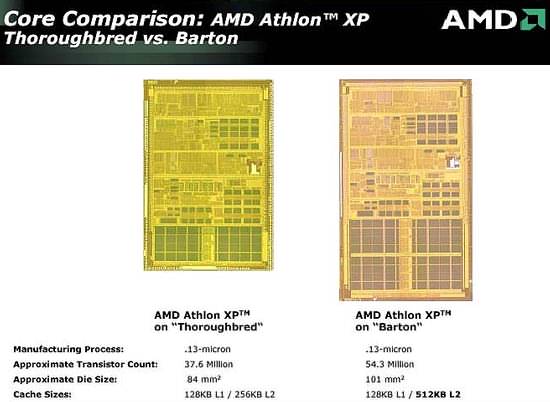
As you can see, the main change of the core in the presented processor was the addition of extra 256 KB of Level 2 Cache, thus, reaching the total of 512 KB of L2. But the following testing will show if the addition of the cache and all the other changes (transistors quantity etc.) will really help the new AMD Athlon XP 3000+ to at least reach the Pentium 4 productivity level in total.
![]()
Processors:
![]() AMD Athlon XP
3000+ (2167 MHz) ½Barton╗, Socket 462
AMD Athlon XP
3000+ (2167 MHz) ½Barton╗, Socket 462
![]() AMD Athlon XP
2700+ (2167 MHz) ½Thoroughbred╗, Socket 462
AMD Athlon XP
2700+ (2167 MHz) ½Thoroughbred╗, Socket 462
![]() Intel Pentium 4
3,06 GHz (Hyper-Threading supported), Socket 478
Intel Pentium 4
3,06 GHz (Hyper-Threading supported), Socket 478
Mainboards:
![]() ASUS A7N8X (BIOS
1002), NVIDIA nForce2 chipset
ASUS A7N8X (BIOS
1002), NVIDIA nForce2 chipset
![]() ASUS A7V8X (BIOS
1011), VIA KT400 chipset
ASUS A7V8X (BIOS
1011), VIA KT400 chipset
![]() Gigabyte 8PE667
(BIOS F3), i845PE Chipset
Gigabyte 8PE667
(BIOS F3), i845PE Chipset
![]() ASUS P4T533 (BIOS
1006 beta 001), i850E Chipset
ASUS P4T533 (BIOS
1006 beta 001), i850E Chipset
Memory:
![]() 2x256 MB
PC2700(DDR333) DDR SDRAM DIMM Samsung, CL 2
2x256 MB
PC2700(DDR333) DDR SDRAM DIMM Samsung, CL 2
![]() 512 MB PC4200 RIMM
RDRAM Samsung
512 MB PC4200 RIMM
RDRAM Samsung
Video Adapter:
![]() Palit Daytona
GeForce4 Ti 4600
Palit Daytona
GeForce4 Ti 4600
Hard Drive:
![]() IBM
IC35L040AVER07-0, 7200 Ņß/ņĶĒ
IBM
IC35L040AVER07-0, 7200 Ņß/ņĶĒ
Software Environment:
Operating System & Drivers:
![]() Windows XP
Professional SP1
Windows XP
Professional SP1
![]() DirectX 8.1b
DirectX 8.1b
![]() Intel Chipset
Software Installation Utility 4.04.1007
Intel Chipset
Software Installation Utility 4.04.1007
![]() Intel Application
Accelerator 2.2.2
Intel Application
Accelerator 2.2.2
![]() Audiodrivers 3.32
Audiodrivers 3.32
![]() VIA Hyperion 4.45
VIA Hyperion 4.45
![]() NVIDIA UDP 2.03
NVIDIA UDP 2.03
![]() NVIDIA Detonator
XP 40.72 (VSync=Off)
NVIDIA Detonator
XP 40.72 (VSync=Off)
Benchmarks:
![]() VirtualDub 1.4.10
+ DivX codec 5.02 Pro
VirtualDub 1.4.10
+ DivX codec 5.02 Pro
![]() WinAce 2.2
WinAce 2.2
![]() WinRAR 3.11
WinRAR 3.11
![]() Discreet 3ds max
4.26
Discreet 3ds max
4.26
![]() MadOnion 3DMark
2001 SE build 330
MadOnion 3DMark
2001 SE build 330
![]() Gray Matter
Studios & Nerve Software Return to Castle Wolfenstein v1.1
Gray Matter
Studios & Nerve Software Return to Castle Wolfenstein v1.1
![]() Croteam/GodGames
Serious Sam: The Second Encounter v1.07
Croteam/GodGames
Serious Sam: The Second Encounter v1.07
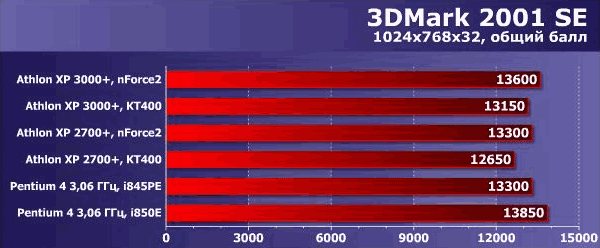
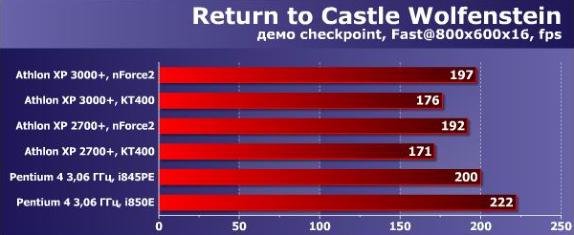
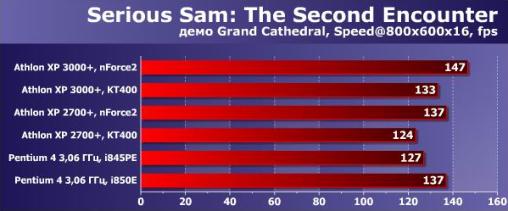
Well, there's nothing really special to comment on here: Pentium 4 with i850E Chipset and PC4200 RDRAM is an unbeatable combination really, because all the games like fast memory. RDRAM remains the fastest, so... Games are Intel's special so nothing amazing was expected from AMD. At all, the new Athlon XP 3000+ was ahead of 2700+ steadily and sharply in the Serious Sam benchmark. Note that in this game Athlon XP + nForce2 bypassed Pentium 4 by 7%, and even a mainstream KT400 got ahead of a mainstream i845PE by 4%.
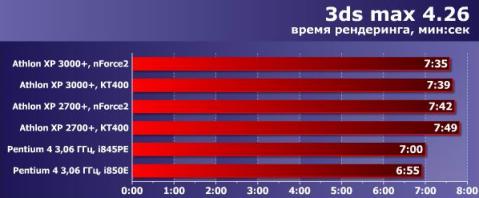
The support of SSE2 instructions in the new v4.2.6 used provided a clear and sure lead for Intel Pentium 4. AMD processors just yield all these SSE2 benchmarks with out any struggle really. But it should also be admitted that the addition of extra 256 KB of L2 cache in the new processor gave almost no increase in the productivity.
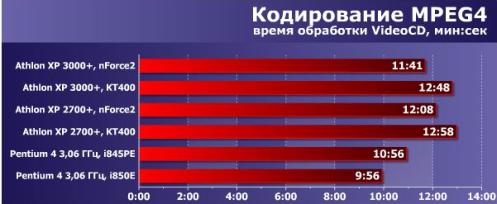
No opponents for Intel Pentium 4 in the MPEG-4 processing (as always). Even a one-channel DDR333 memory used couldn't help AMD to at least enclose the gap. But see again: the new 512 KB L2 cache gives almost no increase in the productivity.
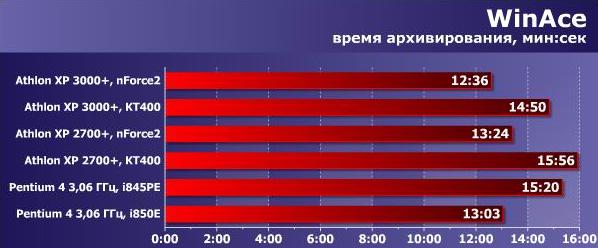
We're actually watching... memory controllers
benchmark: here i845 PE lags (i850E has an improved and much optimized memory
controller) and the time difference between VIA KT400 and nForce 2 is really
huge. Of course, when the chipset operations are poor (like we see in VIA KT400)
the processor's level's cache increase seems to be the main factor. That is why
AMD Athlon XP 3000+ "Barton" here is ahead of 2700+ noticeably.
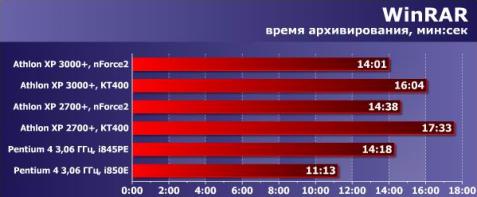
Intel Pentium 4 was far ahead of Athlon XP in this benchmark. Well, you might understand that Athlon and Pentium algorithms priorities are totally different so a clear win for Intel means a clear defeat for Athlon in the application usually.
Conclusion for the new AMD
Athlon XP 3000+ can be expressed in only three words: We expected more... And
the testing was not about if the new Athlon XP could bypass Pentium 4 3,06 GHz
in total. We saw that the increase of the processor's cache doesn't not usually
gives an increase in the productivity. We saw that nForce2 + Athlon XP 2700
combination has done better than Athlon XP 3000 + VIA KT400. That means that
only the acceleration of the processor bus and/or data exchange with the RAM can
allow the increase of the total productivity of Socket A processors so far.
This actually means that AMD Athlon XP 3000+ on the new Barton core is only like
the exhibit for the museum, just to show that AMD processors can be up to the
Pentium 4 productivity standard. But the correlation price/productivity is far
more better for Pentium 4 than for AMD Barton that is now worth about 500$...
and like Pentium 4 3,06 GHz didn't not appeared just today, you know. I
think that this actually leads to a quick decease of AMD Barton processors. The
differences between Memory Bus and FSB frequencies for AMD Athlon XP and Pentium
4 are huge as well. So there's no successful future for AMD Barton and AMD can
only count on their new Athlon 64 and Opteron (for servers) processors. They are
really a new generation. Only they seem to be the processors capable of
"killing" Intel Pentium 4 (or Xeon for servers). If they could even provide the
same productivity... Anyway, according to AMD, there are 10 more months to wait
for them.
(Benchmarks were prepared by my partners, iXBT.com, using the original AMD Athlon XP 3000+ (Barton) processor provided by AMD)
Published on 10.02.03 21:25 GMT